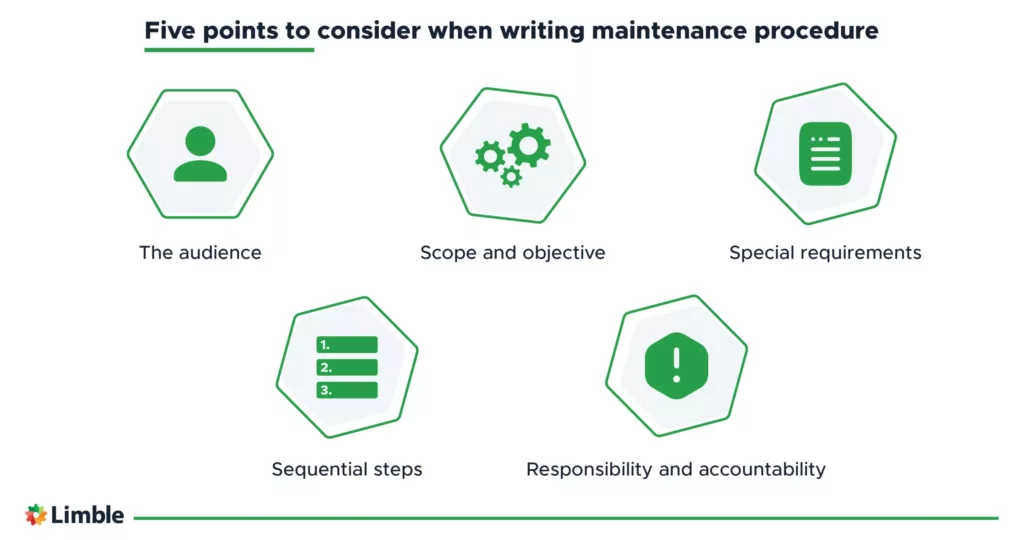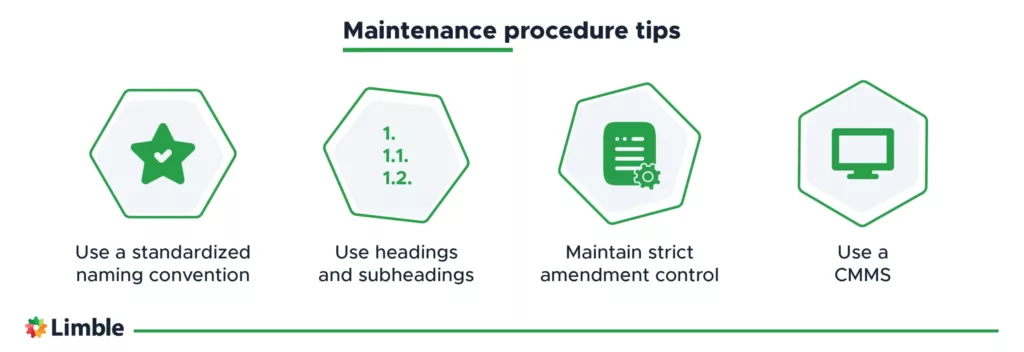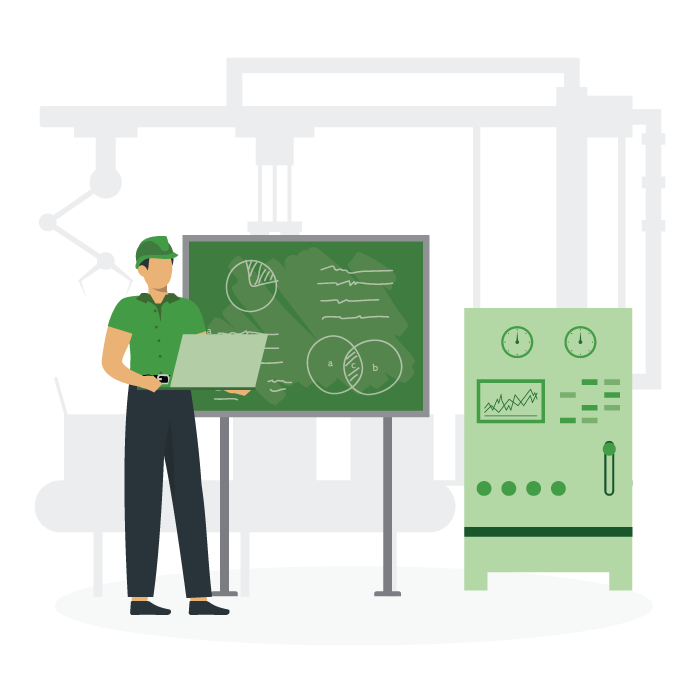Maintenance Procedure
Everything you ever needed to know about maintenance procedure
What is a maintenance procedure?
A maintenance procedure is a complete set of instructions on how a maintenance task has to be completed. Each execution step is laid out in the correct order and is action-oriented.
Organizations use maintenance procedures when:
- A task is lengthy, requires consistency, or is complex
- There are serious consequences from performing the task incorrectly
- There are safety and efficiency concerns.
Table of Contents
What information is in a maintenance procedure?
Why is the quality of a maintenance procedure important?
Follow the PDCA method when writing a maintenance procedure
Things to consider before writing maintenance procedures
Maintenance procedure tips
Maintenance procedures done right
What information is in a maintenance procedure?
Common components of a maintenance procedure are:
- Title and document number
- List of equipment (including personal protective equipment), tools, and parts required for the job
- Safety hazards to be aware of
- A detailed explanation of steps for performing the job
- Diagrams and photos that explain how the job should be done
- Reference documents, e.g. instruction manual, schematics
- Number of people and hours needed to complete the job
- Necessary skills required to complete the job
- Relevant compliance regulations and standards
It is important to note that not every maintenance procedure needs to cover all of these points. Use common sense when deciding on what should be included.
Standard Operating Procedure (SOP)
Create your own routine maintenance SOP with this customizable template.
Why is the quality of a maintenance procedure important?
The basis of a maintenance procedure is to standardize work using the same method, regardless of the technician performing it. This is how to get the desired outcome with minimal variation.
Let’s check an example of a maintenance procedure to inspect an impeller on a pump.
If the task to replace the impeller casing states to “Torque the casing bolts to 22 ft-lb,” the technician gets to decide the process they will follow.
The result may be a cracked impeller casing, a damaged impeller, a leaking pump, or a breach of environmental release legislation.
To make the task more explicit, break it down into several steps showing the required tightening sequence:
- Insert all four impeller bolts and hand tighten
- Tighten the bolts at 12-o-clock and 6-o-clock to 6 ft-lbs
- Tighten the bolts at 9-o-clock and 3-o-clock to 6 ft-lbs
- Tighten the bolts at 12-o-clock and 6-o-clock to 14 ft-lbs
- Tighten the bolts at 9-o-clock and 3-o-clock to 14 ft-lbs
- Tighten all bolts to a final torque of 22 ft-lbs, beginning at the 12-o-clock position and progressing clockwise around the casing.
Failure to standardize maintenance work can lead to increased operational maintenance costs, equipment damage, production delays, compliance issues, and safety breaches.
Follow the PDCA method when writing a maintenance procedure
The Plan, Do, Check, Act methodology (PDCA) is the basis of all major quality systems, and provides a logical and circular process for writing a maintenance procedure.
- Plan
- Do
- Check
- Act
Here are some practical steps to follow during each stage of the PDCA cycle.

Plan
At this stage, pull together all the resources that you’ll need to reference in the procedure or that will inform what you write:
- Parts manuals
- Maintenance manuals
- Specialist test and tooling
- Support and access equipment
- Safety issues regarding the task
- General site safety requirements
- Old procedures or notes from experienced technicians.
Don’t omit graphical resources. You will enhance the readability and comprehension of maintenance procedures by using appropriate drawings, images, or graphics.
Do
Make sure you’re on the location when writing the first draft. You’ll be surprised how many things you would have missed back in the office. Be meticulous, and approach the task as if you were a new technician unfamiliar with the task, recording every little detail.
Many of these may not make it into the final document, but they will help you create a more three-dimensional procedure. As you write, consider additional changes you can make, so that the task is more efficient, effective, or safe.
For some additional writing tips, take a look at our guide on standard operating procedures.
Check
Once you have the first draft, give the document to another technician and have them perform the task. They mustn’t stray from the steps in the procedure unless some steps are missing or incorrect.
If they notice any flaws, they should annotate them onto the draft for subsequent amendment. Once complete, the original writer should update the draft before further testing.
This Do-Check cycle can run through several cycles until the procedure is considered acceptable.
Act
The final draft should be reviewed and approved by everyone responsible for the document, issued a unique identifier or a new version number if it’s a rewrite of an old document, and entered into the CMMS as the approved version.
Previous versions should be archived, and any paper copies destroyed.
Things to consider before writing maintenance procedures
A maintenance procedure must anticipate who will be doing a job, and the full information required to effectively and efficiently complete the procedure and achieve the required objective.
There are five points to consider when writing a procedure.

1) The audience
There are two considerations regarding the audience:
- Clarify intent. Clearly state the intended recipient, individual, role, or team in the preamble to the document. There may be steps in the document that require specialist knowledge, clearances, or approvals — it’s inefficient to have someone begin a process they cannot complete.
- Use simple language. Writing complex technical instructions to a reader who won’t understand them runs the risk of incorrect application of the procedure or tasks being left incomplete.
2) Scope and objective of the maintenance procedure
The context of a maintenance procedure must be clearly described at the beginning of the document. Highlighting the procedure’s intended application and the expected outcomes will help technicians perform work properly, ensuring both assets and people stay safe.
Incorrect application of a maintenance procedure is inefficient as it costs money and time — even when there are no negative outcomes.
Here’s one way of writing a procedure’s objective and scope.
“This maintenance procedure applies to all Busch Rotary Lobe Vacuum pumps, models MI 1354BV, MI 1504BV, and MI 1352BV. It supports the company’s planned maintenance task SERV05234-3 and meets the original equipment manufacturer’s requirement for a three-month oil change.”
There is no ambiguity in this contextual statement as it clearly defines the make, models, and type of pump the maintenance procedure covers.
It also clarifies the outcome of the procedure and the related planned maintenance task.
3) Special requirements
List any special requirements or prerequisites for completing the maintenance procedure successfully — especially when the job is large or complex.
It’s more efficient to place this list at the beginning of the procedure. That way, the person doing the job can assemble all required components before heading to the job site.
These items might include:
- Safety precautions (lock out, tag out (LOTO), PPE requirements)
- Instruction manuals (it would be neat if you also provided manual references)
- Specialized tooling (jigs, stands, or OEM tools)
- Test equipment
- Spare parts
- Consumables
- Other maintenance procedures (like isolation procedures)
- Trade skills required (electrical, mechanical, engineering)
- Number of personnel required to complete the task safely
4) Sequential steps of the maintenance procedure
The content must consist of each sequential step that is required to complete the procedure and achieve its intended objective.
Make each step a simple action rather than using long compound sentences with multiple tasks.
If people are reading the procedure, doing a task, then returning to the procedure, it’s too easy to miss something buried deep inside a long paragraph.
5) Responsibility and accountability
There are 3 roles here. Be sure to define them in each maintenance procedure you write.
- Document owner – the person(s) whose job it is to ensure the procedure is up-to-date and accurate; usually the maintenance department, engineering department, or quality manager
- Responsible party – the person(s) whose job it is to perform work according to the procedure; usually maintenance technician
- Accountable party – the person(s) whose job must take responsibility for actions taken off of the procedure; usually a maintenance manager or supervisor
The Essential Guide to CMMS
Download this helpful guide to everything a CMMS has to offer.

Maintenance procedure tips
The following suggestions ensure a clean, consistent, and useable procedure while complying with basic quality management requirements.

1) Use a standardized naming convention
It’s important to use standardized names within procedures and across documents for:
- Improved technician understanding
- Ensuring a CMMS search returns all applicable documents
- Efficiency in categorization.
If you use the longhand name of an asset in one place in your document, continue the convention throughout. Choose one, stick with it, and ensure the convention is consistent across all maintenance documents.
The naming of your procedures should also follow a logical structure.
Depending on what your CMMS supports, these names can usually be a mix of alphanumeric characters. You may use alpha descriptors at the front of the document name, which enables easy categorization at a glance, followed by a number and then a dash number denoting amendments status.
For example, SER653800-6 might tell you the document is a servicing procedure on its sixth amendment, while MAI876400-3 is a maintenance procedure on its third amendment.
Lastly, make sure that you create a system that does not allow duplicate names or numbers.
2) Use headings and subheadings to separate discreet tasks
Let’s assume we have a sub-task that requires you to isolate a standby pump.
The task heading will be “2.2 Isolate the standby pump” and includes:
2.2-1 Press stop on the pump switch
2.2-2 Close the inlet valve
2.2-3 Close the outlet valve
2.2-4 Trip the pump circuit breaker in the electrical sub-panel
2.2-5 Isolate the pump electrically using LOTO procedure LO39876-8
2.2-6 Test for correct isolation using test procedure TE08124-5
With that completed, the next task might be “2.3 Remove Impeller Casing”, with a list of subsequent tasks that guide the technician through the correct technique.
3) Maintain strict amendment control
You do not want to be using outdated maintenance procedures. You will lose consistency and efficiency in your maintenance, possibly exposing workers to safety risks.
When a maintenance procedure is updated, ensure a clear change in your naming convention to indicate the latest version. Destroy all old paper copies in circulation and/or update them if they are stored in your CMMS.
The easiest way to ensure version control is not to use paper copies, issuing technicians portable electronic devices instead, to access the approved copy held on the CMMS — guaranteeing currency.
4) Use CMMS for maintenance procedure management
A computerized maintenance management system (CMMS) automates many issues regarding maintenance procedure management.
The CMMS will treat each maintenance procedure as an asset and:
- Help you automate naming conventions
- Track document currency
- Store current versions
- Provide quick and easy access to procedures, regardless of technician location.
It allows you to set document review dates, alerting the responsible person to the need for action, and showing the action overdue until acquitted.
Each CMMS also has a powerful search function to search through every document for specific terms or references.
Finally, what you might find most useful is how planned maintenance tasks and procedures can be linked to ensure work packs contain all the necessary documentation for maximum technician efficiency.
Want to see Limble in action? Get started for free today!
Maintenance procedures done right
Writing a maintenance procedure is not difficult, but it requires careful attention to style, consistency, and content to provide tangible benefits.
It’s also not a solo endeavor; using others to review and validate your work helps remove any ambiguity you may not see as the writer.
Think of a well-written maintenance procedure as one of the assets you have in your business. While it may not bring in revenue, it can:
- Prevent safety incidents
- Improve maintenance efficiency and effectiveness
- Reduce cost
- Improve equipment reliability and uptime
To find out more about Limble CMMS and how it can help you handle the management of maintenance procedures, feel free to contact us via email, request a free demo, or start a free trial.


